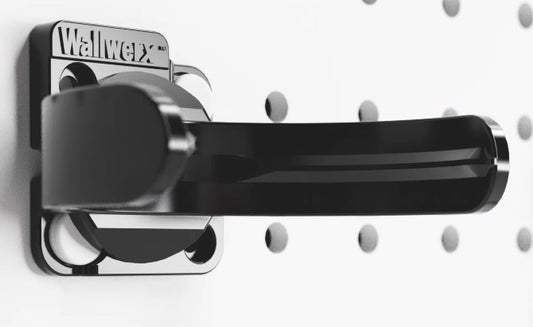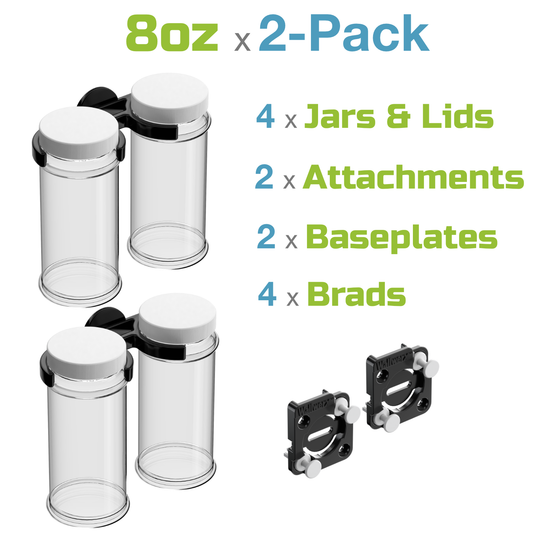Pegboard. Just the word conjures up images of meticulously organized garages, kitchens, and workshops. The thought immediately brings me back to my grandfathers woodworking shed, completely clad with pegboard, where anything not stacked on a shelf was hanging on a pegboard.
For decades, pegboard was the go-to wall storage solution, offering efficiency, versatility, and simplicity. From DIYers to professionals, pegboard became the ultimate backdrop for small item organization. But then came the competition. Rail systems, slatwalls, magnetic options—oh my!
Many people have since claimed that the long-standing king of organization has been dethroned.
The answer is simple: absolutely not. While innovation is great and has certainly offered some fancy new alternatives, pegboard still reigns supreme in the world of affordable and effective wall organization. Let’s take a quick trip through pegboard's past, why it still matters, and how Wallwerx has taken this classic system into the modern age.
A Brief History of Pegboard Dominance
Pegboard, which is essentially perforated hardboard, has been around since the 1800s. It took off in the 1950s, quickly emerging as the leader in wall storage and organization. Those rows of perfectly aligned holes provided a simple yet genius way to hang tools, kitchenware, and craft supplies. What made it a hit was its incredible flexibility—by just inserting a hook or bracket, you had a custom wall-mounted organizer.
For decades, pegboard’s universal design, including its standard pegboard dimensions and pegboard hole size, made it a natural fit for everything from home garages to professional workshops. And, frankly, it’s hard to beat in terms of cost-effectiveness, especially when you just need a space to store small items like screwdrivers, scissors, or spices.
Modern Alternatives & Innovations
With time, newer wall storage systems started to creep in. Rail systems, slatwalls, magnetic storage—each came with its own unique benefits. Some offered extra strength for hanging heavy items like bicycles or, I don’t know, a canoe. Rail systems provided solid options for holding hefty tools or bulky items that pegboard struggled with. Slatwalls brought a sleek, modern look that appealed to people interested in transforming their storage into something more design-focused.
And magnetic options? Well, who doesn’t like the idea of slapping up a hammer or wrench with a satisfying clink? These innovations provided viable alternatives for specific needs, and let’s give credit where credit’s due—they addressed some of pegboard’s inherent limitations. But no matter how strong, fancy, or futuristic these options were, they never fully replaced the pegboard.
Pegboard Reimagined: Modern Materials for Modern Needs
One of the biggest improvements in recent years has been the reimagining of pegboard itself. Gone are the days when pegboard was strictly made of fiberboard or wood. Now, modern pegboards are crafted from a variety of materials that increase strength, durability, weight capacity, and even ease of installation.
For lighter-duty applications, plastic pegboards offer a great option. They’re resistant to moisture, making them perfect for places like laundry rooms or craft areas. On the other end of the spectrum, metal pegboards have emerged for heavy-duty applications. Steel versions can handle significantly more weight, making them ideal for garages and workshops where you need to hang heavier tools or equipment. These advancements mean that pegboard can now take on more specialized roles without losing its core benefits.
What’s Wrong with Classic Pegboard?
Okay, so pegboard isn’t perfect. The original wire hooks and accessories often feel like they were designed to test your patience. They pop out at the worst possible moment, swing precariously when bumped, and often look...let’s say, utilitarian at best. This might explain why some folks started searching for alternatives. Wire accessories, while cost-effective and sufficient for light items, struggle when it comes to security, aesthetics, and specialized tasks.
Enter Wallwerx: Pegboard Evolved
If pegboard is still the king of organization, consider Wallwerx its wardrobe of modern, performance wear. Wallwerx takes everything we love about pegboard and gives it a 21st-century makeover.
With Wallwerx’s advanced pegboard-compatible accessories, you can say goodbye to shaky wire hooks and hello to secure, functional, and stylish solutions. From wall-mounted clear plastic jars for small items to utility hooks and specialized tool holders, Wallwerx has transformed pegboard into a system that can handle everything from your craft room to your garage.
One of the standout features of Wallwerx’s system is its baseplate. Think of it as a virtual pegboard that can turn any wall into a customized organization hub. The baseplate allows for the use of interchangeable Wallwerx attachments, making it incredibly easy to swap in and out different pegboard accessories as your needs change. It works not just on traditional pegboard but also on any flat surface. That’s right—your drywall, wooden paneling, or cinder block workshop wall can all become pegboard-like, thanks to this clever solution.
Long Live Pegboard
So, while pegboard might not be the only game in town, it remains the gold standard for small-item storage. New systems have brought plenty of fresh ideas to the table, but when it comes to affordability, versatility, and efficiency, pegboard still holds its ground. Thanks to companies like Wallwerx, pegboard has also evolved into something that suits modern tastes and needs.
So, pegboard isn’t dead. It’s very much alive—and thriving.







